► Ford Fiesta ST long-term review
► Nine months with a great hot hatch
► Our regular reports
Month 9 living with a Fiesta ST: the long-term verdict
Being a passenger in your own car is always a slightly odd sensation. But this is odder than most. At the wheel is affable Belgian engineer David Put, one of Ford Performance’s senior dynamics wizards (and a driver of serious talent), and we’re currently blatting around a serpentine test circuit. Plunging through thick forest, the little ST dances light on its feet over crests and dangles its inside rear wheel as it’s flicked into controlled slides by Put.
Ford’s Lommel proving ground in rural Belgium is a sort of Area 51 for car development, a complex of test circuits, steering pads and punishingly bumpy durability test zones, ringed by a banked speed bowl and hidden from prying eyes by thick forest. Access is rarely granted to people outside the company, and it’s unusual for Ford to allow us to drive our long-term-test Fiesta ST through Lommel’s heftily padlocked gates. It’s here that the Fiesta’s sparkling chassis was developed, and this visit is a rare chance to bring it back to the place where it learnt everything it knows.
Put was one of the ST’s main dynamics engineers. ‘We went through God knows how many damper settings. I think we must have changed pretty much every parameter possible in the dampers.’
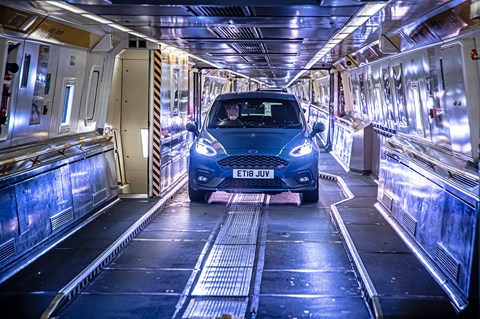
Those dampers were signed-off partially in real life in Wales – ‘There’s nowhere like it,’ says Put – and also on replica UK roads in Lommel. The complex includes a replica of bumpy, scarred roads near Ford’s Essex base, and as Put pilots the Fiesta over it he explains that this road was one of the key tests.
If the Fiesta had a higher price, Put’s personal wishlist would be bigger brakes for track work and adaptive dampers for the best of both worlds, ride quality and responsive handling.
David and I swap seats so I can see how it feels around Lommel’s Route 7, a track so exciting its name could be mentioned in the same breath as the Nürburgring and Route Napoleon. You can see how its corners have directly informed the way the Fiesta handles, particularly in the constant-radius curves designed to fine-tune how the car reacts if you shut the throttle or alter your line mid-bend. The Fiesta’s ultra-fast 12:1 steering ratio makes total sense here.
‘Sometimes people find it so fast that at first they get spooked,’ Put says. ‘I tell them to just try it for an hour and see what they think then.’ More impressive still is that despite its apex-hungry response on track, the Ford also feels dead-set and stable in a straight line. That helped reduced fatigue on the long motorway trek from the UK to Lommel.
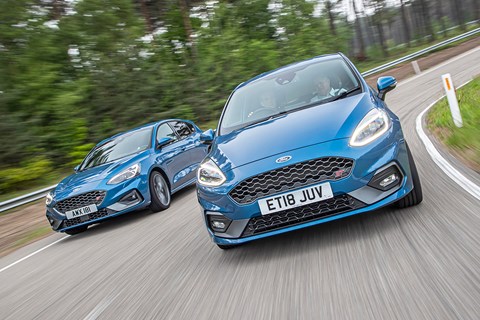
One thing I’m curious about is the Fiesta’s handling balance: it’s markedly more biased towards oversteer than many regular hatchbacks. Was there internal debate about signing off a car so lively? ‘The normal way of thinking is that understeer is safe and oversteer is dangerous,’ Put says, going on to explain that he believes the opposite can be true if a car is developed with care; if a car behaves safely at its limits and recovers from oversteer in a controlled way, it can help drivers stay on the correct side of the road.
Also here is Leo Roeks, head of Ford Performance in Europe, and the man who signs off the big decisions.
‘I drove these guys mad,’ confesses Roeks. ‘I kept telling them that the car wasn’t good enough – we made so many changes. We went round in circles. If you change one thing, it affects all the other parameters, so you have to change everything again accordingly.’
I’d say it paid off. This Belgian caper is the ST’s last adventure before it leaves us, and it’ll be missed. Its downsides fade into irrelevance with time, and while I still feel the ride comfort is a tad punishing for day-to-day use, especially at urban speeds, one run through a curving slip road or bendy B-road is enough to make it feel an entirely fair trade for the ST’s agility.
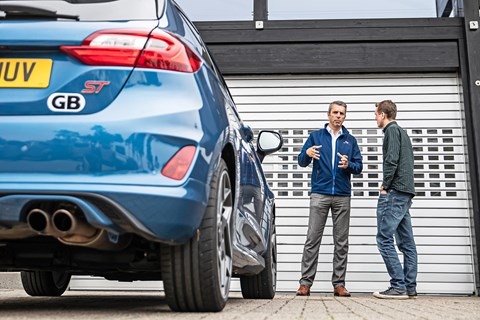
The over-bolstered front sports seats have worn in with use, like a pair of once-stiff, now-comfy trainers, although the leather on the driver’s door-side bolster is starting to scuff.
There was also the curious non-start episode mentioned last month, although since the Fiesta’s been otherwise entirely trouble-free I’m putting it down as an isolated incident. And chalking the ST up as a modern classic. In the future, I really do think people will look back on this car as being just as epochal a hot hatch as the Peugeot 205 GTI, Renault Clio Williams et al.
‘Most customers can’t talk to me about linearity and tuck-in but if they say it drives nicely, I’m overjoyed,’ says Roeks. ‘If they say it puts a smile on their face, that is the feedback I’m hoping to get.’
Well, the Fiesta really has put a smile on my face, every day for the past nine months. It’s a special little car, this Ford.
By James Taylor
Logbook: Ford Fiesta ST
Price £21,995 (£24,890 as tested)
Performance 1499cc turbo 3-cyl, 197bhp, 6.5sec 0-62mph, 144mph
Efficiency 47.1mpg (official), 38.3mpg (tested), 136g/km CO2
Energy cost 20.0p per mile
Miles this month 1708
Total miles 9002
Month 8 living with a Fiesta ST: Y2k bug arrives at last
Well, this is odd. I’m blipping the Fiesta’s key and the doors have unlocked but the door mirrors have stayed folded; now I’m pressing the starter button and there’s a faint electronic hum from somewhere within the car’s bowels but nothing from the engine, and the dashboard and touchscreen are blank. Flat battery, maybe? But the headlights are working fine.
After 20 minutes of pondering and prodding buttons, suddenly it springs to life and it’s been completely fine since. An isolated incident, then. Maybe coincidentally, maybe not, since that mysterious wobble the interior light stayed on for a couple of weeks, regardless of which position its switch was in. It’s since fixed itself.
By James Taylor
Logbook: Ford Fiesta ST
Price £21,995 (£24,890 as tested)
Performance 1499cc turbo 3-cyl, 197bhp, 6.5sec 0-62mph, 144mph
Efficiency 47.1mpg (official), 35.6mpg (tested), 136g/km CO2
Energy cost 20.0p per mile
Miles this month 1161
Total miles 7294
Month 7 living with a Fiesta ST: you drive our car
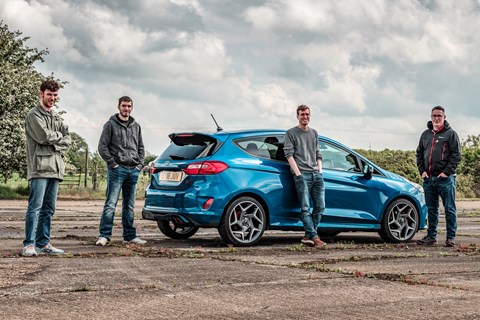
So infatuated have I become with the Fiesta that, like the object of Percy Sledge’s affections, if it’s bad I can’t see it. Maybe a fresh perspective from three impartial CAR readers can help me work out if it really is as good as I think it is. After all, loving eyes can never see. Each of our three-strong reader panel loves driving and knows his automotive onions, and between them they’ve owned a host of hot hatches. Will the Fiesta ST impress them as it has me?
Meet the drivers

The JDM enthusiast
Mechanical engineer, part-time writer and full-time car enthusiast Luke Roberts has a taste for naturally-aspirated Japanese performance cars from the ’90s – but he’s intrigued by the Fiesta ST.

The enemy spy
Daniel Somerton drives one of the Fiesta ST’s mortal enemies, a Renault Sport Clio, and is also an engineer at Renault’s F1 team. What does he make of the Clio’s adversary?

The prospective buyer
Chris Murat has been reading CAR for years 13, rides a Ducati at weekends and runs a Skoda Octavia vRS in the week – but wonders if the ST might be enough fun to justify downsizing.
Luke Roberts
Luke has a fondness for Japanese cars, particularly of the leftfield, ’90s and naturally-aspirated variety. He’s just purchased a Mk3 Toyota MR2 to go with his Honda Concerto and Suzuki Baleno GSR, and has previously owned a DC2 Honda Integra and a track-modded Nissan Almera GTi (‘My favourite so far; unfortunately rust got the better of it’). But he’s intrigued by the ST: ‘I hear a lot of good things about the Fiesta’s handling and I’d like to see whether this digital age of hot hatches retains the feel and character I believe is paramount.’
Sweeping through the B-road-riddled countryside in this corner of Lincolnshire, the ST’s off to a good start: ‘The gearshift’s very smooth and crisp. There’s no fumbling around in the gate.’
I find the ST’s ride pretty punishing but Luke’s more forgiving of its unforgiving suspension: ‘I think it rides quite well for what it is, especially considering it’s on low-profile 18s. I can see a lot of camber on the front, which is probably why it feels so darty – the steering doesn’t need a lot of input.’
Unfortunately the same could be said for the brake pedal. Like me, Luke finds the brakes overly-assisted: ‘I find it tricky to modulate them. But that’s something I find with a lot of modern cars.’ On that front, he rues the woolly edge to the ST’s turbocharged engine’s throttle response. ‘It’s not very laggy at all, but you still have to pre-empt it just a bit when you get on the power – but I’m comparing it with naturally-aspirated cars, I guess.’
Still, as we reach a long, well-sighted stretch and the rev counter’s needle reaches the redline, the ST argues a good rejoinder for forced induction. ‘The midrange is definitely strong. And the engine’s flexible. It feels quite docile at urban speeds, unassuming. Then when you turn it on…’
Would Luke look to Dagenham for his next performance car? ‘I do like this car. But I always feel turbos don’t quite have the crispness of an NA engine. But the chassis feels good, really good. That’s the standout.’
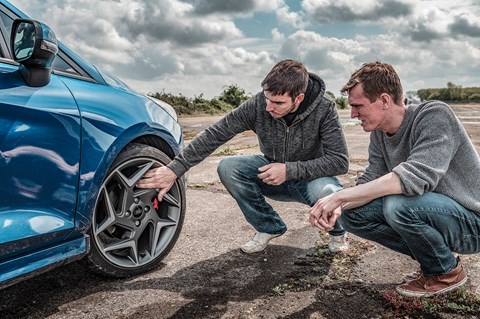
Daniel Somerton
Dan Somerton is used to speed. An F1 engineer who’s spent time at various teams but now crafts the gearboxes in Ricciardo and Hulkenberg’s Renault racers, he’s just adapting to life working full-time at HQ after previously flying to every race with the team.
That’s giving him more time to spend with his RS Clio, a natural rival to the fast Ford. How does it compare? ‘Well, my car’s remapped to 255bhp, 220 at the wheels, so naturally it feels faster than the [197bhp] Fiesta. But this pulls really well. You wouldn’t know it was a three-cylinder – you could convince someone it was a 2.0-litre four. Let’s try fourth gear… there, it pulls from no revs and virtually no lag. I like the sound, too,’ he nods, approvingly.
Three pedals and a lever is a reacquaintance for Dan after the paddleshift Clio, but he adapts quickly, having spent plenty of time heel-and-toeing his previous Megane 265 and Clio 197.
So that’s a big tick for straight-line performance. What about corners? ‘It’s planted. There’s a bit of understeer, but you expect that from a road car [Somerton’s Clio wears softer-than-standard track-focused tyres]. The steering’s positive and I like the speed of the rack. It feels a bit stiffer than the Clio; I think it’s on a par for handling on the road but I feel on a track, the Clio would be faster.’
The ST’s braking performance makes a big impression on Dan: ‘It stops so well on standard brakes.’
Good enough to turn this long-time RS advocate’s head? ‘I’m pleasantly surprised. It drives well and it has a nice feel. If someone was considering one, and asked my opinion, I’d tell them to get one. But I’m keeping my Clio!’
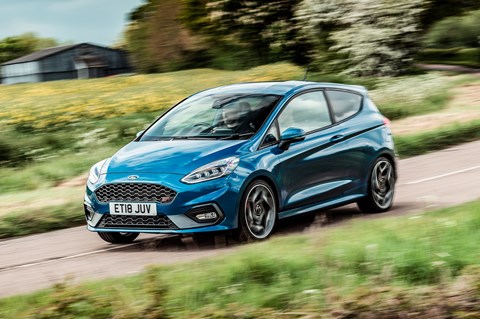
Chris Murat
Chris already drives a new hot hatch, but it’s at the opposite end of the scale to the bite-sized, boisterous Fiesta, the more grown-up (in terms of both size and character) Skoda Octavia vRS. As its lease’s wick burns down, he wonders if the smaller but more playful Fiesta could be worth a look – and, having followed its story on these pages, if it’s as much fun as we’ve cracked it up to be. It doesn’t take long: ‘In a word, yes,’ smiles Chris, a few miles in. ‘The gearchange is really short-throw, and I like the sound. Almost like a smaller, gruffer Porsche.’
Like Dan, he’s impressed by how hard the three-pot engine punches for its size. ‘The torque is almost diesel-esque. It pulls really well, even in sixth, and the low-down power delivery means you don’t have to rev it, which in turn means it isn’t tiring. In fact, it’s really quite docile at town speeds.’
I call out the road noise kicked out by the comparatively fat tyres, and the awkwardly bolstered seats: could Chris imagine driving it every day? ‘I don’t mind the road noise, actually. I do find the seats tight, although they grip you well. The steering wheel is tactile, but the interior plastics are scratchy, and I’m not a fan of the touchscreen – it looks like it’s stuck on rather than integrated into the dash, but a lot of manufacturers are doing that.’
Chris’s thoughts tally with mine on the ST’s paintjob – wouldn’t a brighter shade suit it better? ‘Some previous performance Fords were finished in really quite bright blues; this looks duller by comparison.’
But Chris is clear these are minor nitpicks, and watching his expression as he points the ST’s fast-responding nose into another corner I can tell he’s fallen for it as strongly as I have. ‘After a bad day, this car would cheer you up, no question.’
By James Taylor
Logbook: Ford Fiesta ST
Price £21,995 (£24,890 as tested)
Performance 1499cc turbo 3-cyl, 197bhp, 6.5sec 0-62mph, 144mph
Efficiency 47.1mpg (official), 29.0mpg (tested), 136g/km CO2
Energy cost 20.0p per mile
Miles this month 489
Total miles 6133
Month 6 living with a Fiesta ST: the fine details
Slicker shifter
The more miles I put on the ST, the more I’m convinced its gearchange is one of the best H-patterns in production today. Slick, short throw, fast and easy, it’s a dream manual. Its ratios are spot-on for B-roads, but I wonder if a taller sixth gear might be preferable on motorways.
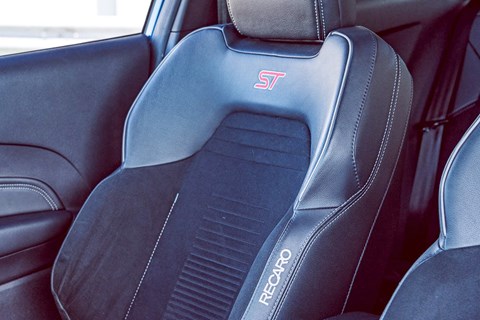
Inappropriate hugging
I’m not the only person to struggle with the over-bolstered Recaros; they pin my shoulders inwards at the top, while other ST drivers I’ve spoken with have complained of waist pinching. Other hot hatches find better, less bulgy, seats.
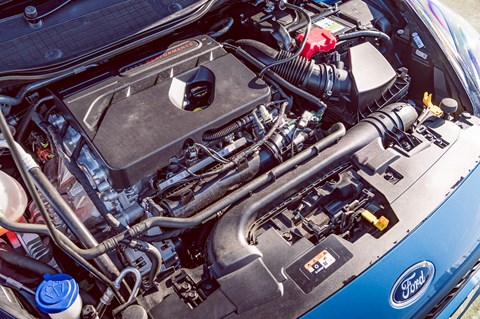
Three cylinders… at most
As the miles tick by the 1.5-litre turbo triple seems to get faster. Its mid-range punch feels more akin to a 2.0-litre four than a three-pot, and the cylinder deactivation function, which turns it into a 1.0-litre twin under low loads, is all but imperceptible.
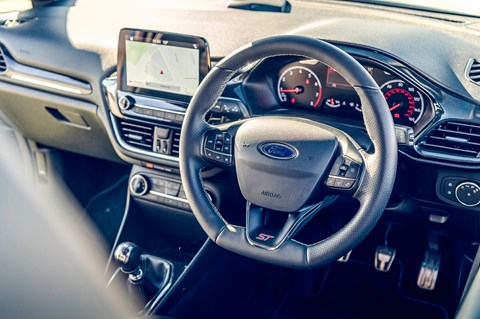
Darty McDartface
I initially felt the steering was too fast for its own good, but now I’ve got used to it the set-up feels more natural, and the tiny amount of lock needed to point the ST’s nose into a corner gives it a remarkable sense of agility.
By James Taylor
Logbook: Ford Fiesta ST
Price £21,995 (£24,890 as tested)
Performance 1499cc turbo 3-cyl, 197bhp, 6.5sec 0-62mph, 144mph
Efficiency 47.1mpg (official), 34.8mpg (tested), 136g/km CO2
Energy cost 16.0p per mile
Miles this month 845
Total miles 5644
Month 5 of our Ford Fiesta long-term test: swapping notes with an owner
Long-term tests tell you plenty about a car but the picture’s always different when you’ve bought one for real. Just as my friend Lawrence has done; the silver car pictured alongside CAR’s blue one is his ST.
‘I was such a fan of the old car I almost didn’t want to like the new one,’ he reflects, ‘but it all works so well. Although I do prefer the old four-cylinder engine…’
He’s still running his in; our fully loosened-up car feels a shade quicker, and rides almost as well despite its inch-bigger wheels. Lawrence’s is a mid-spec ST-2 to our top-line ST-3 but feels just as luxurious thanks to a judicious sprinkling of options (and it has the heated steering wheel ours misses, a quirk of being an early-build car).
By James Taylor
Logbook: Ford Fiesta ST
Price £21,995 (£24,890 as tested)
Performance 1499cc turbo 3-cyl, 197bhp, 6.5sec 0-62mph, 144mph
Efficiency 47.1mpg (official), 44.1mpg (tested), 136g/km CO2
Energy cost 13.6p per mile
Miles this month 760
Total miles 4799
Month 4 living with a Ford Fiesta ST: X marks the fun spot
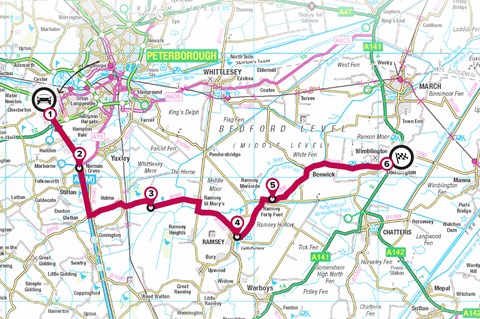
1. The mandatory pitstop
The ST’s downsized three-cylinder engine supposedly helps it eke its way to 47mpg but our economy has been averaging just over 30. Fuel economy has improved by 22 percent since I got the keys back from my colleagues after last month, though…

2. An A1 drive experience
A brief stint southbound on the A1 highlights that the ST isn’t the happiest cruise companion, its jiggly ride and white-noise tyre roar a reminder that it would really rather turn off the motorway and find some corners.
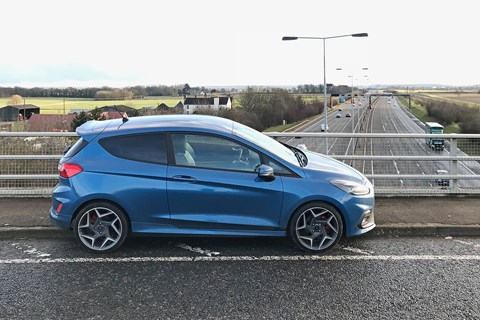
3. Getting kicks on the B660
Briefly joining one of the Midlands’ finest driving roads, the B660. High-speed direction changes, big stops, tricky cambers – it’s got the lot, and the ST feels right at home.
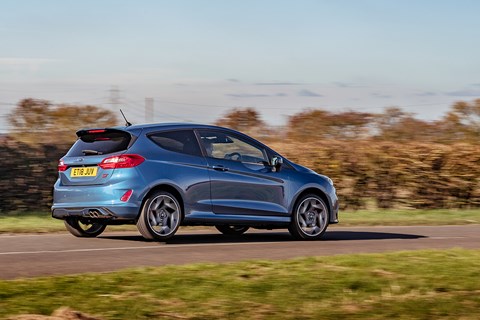
4. Fenland fling
This well-sighted sweep of switchbacks on the Peterborough hinterland is a test for any car’s dynamics. The Fiesta’s reserves of front-end grip never cease to amaze – few cars at any price turn in this crisply.
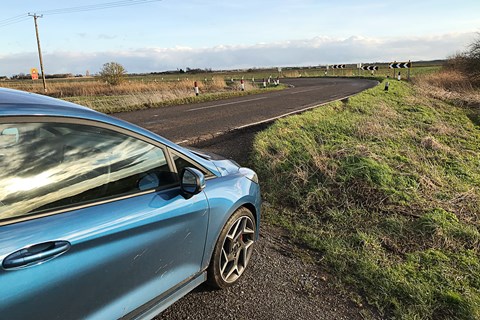
5. Bumpy on the B1096
This kind of uneven, lumpy tarmac is one of the few B-road scenarios where the ST doesn’t feel entirely happy, its firm suspension hopping, skipping and jumping rather than flowing with the road.
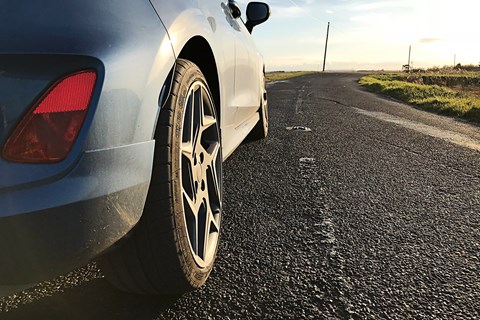
6. Stop-dead stoppers
On roads like these the brakes get quite a work-out and the Fiesta’s small but mighty anchors are superb. When we drove the ST back-to-back with the Alpine A110 in CAR June 2018 it could outbrake the sports car, despite weighing more.
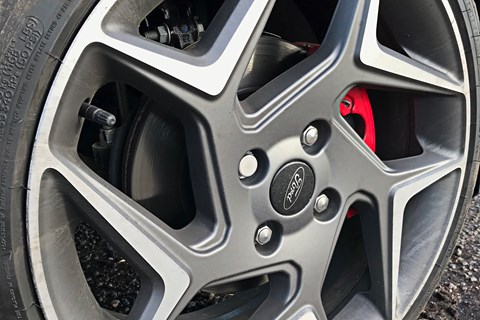
By James Taylor
Logbook Ford Fiesta ST
Engine 1499cc 12v turbo 3-cyl, 197bhp @ 6000rpm, 214lb ft @ 1600rpm
Transmission 6-speed manual, limited-slip differential, front-wheel drive
Stats 6.5sec 0-62mph, 144mph, 136g/km CO2
Price £21,995
As tested £24,890
Miles this month 1006
Total 4039
Our mpg 33.9
Official mpg 47.1
Energy cost 17p per mile
Month 3 living with a Ford Fiesta ST: in high demand
Every time I reach for the Fiesta ST’s keys there’s nothing but an empty hook and the faint sound of wheelspin out in the office car park.
Tim Pollard is so impressed by the ST he considers it an almost perfect junior hot hatch, with few shortcomings save some of the less ergonomic switchgear, small door mirrors and un-small turning circle.
‘It holds high the values of earlier XR2s and STs: uncomplicated old-school hot-hatch fun, with an immersive, fizzy character that’s so rounded, so right,’ Pollard says. ‘Who needs a Fiesta RS when the ST is this good?’

Jake Groves and Curtis Moldrich are big fans, too, although Moldrich has his doubts about the steering, finding its hypersensitive response peculiar. Groves agrees it might be slightly too responsive for its own good, but feels it’s worth it for the fun factor.
‘Sometimes on bumpy roads, because the suspension’s so stiff, it jars your arms,’ he says. ‘But how many cars for this money have steering that feels that good?’
Although the super-quick steering is a big part of the ST’s character, I can’t help but feel it would be even more satisfying in longer, faster corners with a slightly slower, more measured rate of response. Sometimes in long corners I find the steering a bit too all-or-nothing in its response rate, like playing an old PlayStation 1 game with arrow keys instead of the joystick.
Meanwhile, more usefully, CAR senior designer Rebecca Wilshere has tested the supermini-sized bodyshell’s capacity to the limit by squeezing in people, luggage and a border collie for good measure on a long road trip, and returned impressed by the relatively tall-roofed Fiesta’s surprising depths of practicality. I’ll be back behind the ST’s highly strung steering wheel in time for next month, provided I find a better hiding place for the keys in the meantime.
By James Taylor
Logbook Ford Fiesta ST
Engine 1499cc 12v turbo 3-cyl, 197bhp @ 6000rpm, 214lb ft @ 1600rpm
Transmission 6-speed manual, limited-slip differential, front-wheel drive
Stats 6.5sec 0-62mph, 144mph, 136g/km CO2
Price £21,995
As tested £24,890
Miles this month 1289
Total 3033
Our mpg 27.7
Official mpg 47.1
Fuel this month £213.38
Extra costs None
Month 2 living with a Ford Fiesta ST: intruder alert
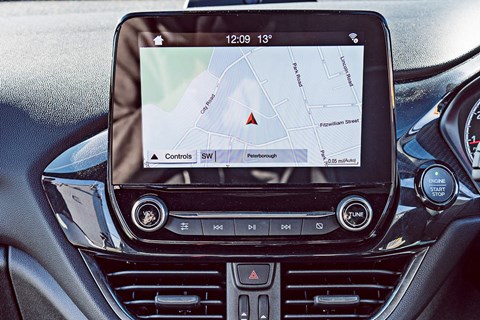
Long journey ahead. Prod postcode into the Ford’s fiddly nav touchscreen and plug phone in (it’s on three per cent battery – the terror!). Apple CarPlay is triggered automatically, and the car’s regular sat-nav system is disabled in favour of Apple Maps. You don’t want to use Apple Maps – you’ve learned that the hard way – and besides, you’re going to Wales, where there’s no signal.
A lengthy voyage through the Sync system’s menus and sub-menus ensues to eventually work out how to switch Apple Maps off so you can charge your phone at the same time as using the car’s nav. When you finally set off you’re late and flustered. Onto the motorway and you still haven’t unwound. The busy suspension’s ultra-firm ride is irksome, and the steering’s super-quick response can be wearying. Steering engineers sometimes talk of building-in a ‘sneeze factor’, but the ST’s is so sharp it feels like a gesundheit moment would see you doing a 360 on the spot.
So it says everything about how good the Fiesta gets when you exit the motorway that by the time you’ve reached your destination you’ve completely forgiven it. Few cars are better companions on a winding road.
By James Taylor
Logbook Ford Fiesta ST
Engine 1499cc 12v turbo 3-cyl, 197bhp @ 6000rpm, 214lb ft @ 1600rpm
Transmission 6-speed manual, limited-slip differential, front-wheel drive
Stats 6.5sec 0-62mph, 144mph, 136g/km CO2
Price £21,995
As tested £24,890
Miles this month 1024
Total 1744
Our mpg 34.6
Official mpg 47.1
Fuel this month £140.66
Extra costs None
Month 1 living with a Fiesta ST: hello and welcome
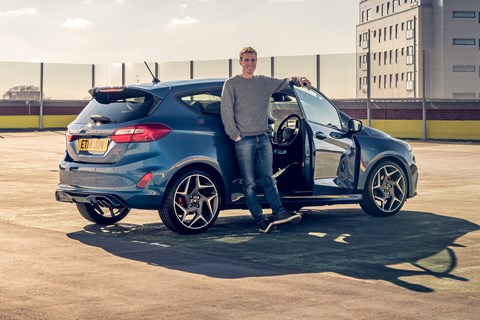
Ain’t broke, don’t mess; winning formula, don’t fix. The old 2012-2017 Fiesta ST is a bona fide modern classic, a hot hatch so good it seemed any meddling would inevitably make it worse. Had Ford just stuck some new body panels on it and made the dash ever so slightly less plasticky that would have been quite enough, thank you. But fiddle Ford has. There’s a new engine under the bonnet (a 1.5-litre three-cylinder in place of the old car’s 1.6-litre four), wider track, new suspension, faster steering… and the good news is, it’s still brilliant.
There are plenty of hints in your first few feet out of the car park: the perfectly weighted pedals, the short-throw gearshift, the mild torque steer out of the first junction. Then, lazily turning into the first roundabout on the way home, the front Michelins gleefully chomp into the tarmac like a kid into a bag of sweets, the inside rear wheel gains an inch or two of fresh air beneath it, and you can’t help but crease into a smile. It’s still a riotous little scamp.
In a world where many hatches are now available only in five-door form to cut manufacturing costs (including the rival Renault Clio RS), the Fiesta gets a choice of three- or five-door bodies. Ours is a three-door in top ST-3 trim, which costs around £22k compared with the base ST-1’s sub-£20k starting price and the middle ST-2’s £20,495.
For the extra outlay, you get 18-inch wheels (which CAR’s Chris Chilton memorably described as looking ‘like an ’89 XR2i’s spun out in a centrifuge’), auto wipers, keyless entry, rear parking camera and sensors, and heated seats; probably more than you really need in a supermini, in all honesty. Our car’s also fitted with the optional Performance Pack, which includes a Quaife limited-slip differential. It finds ferocious traction out of slow corners (here’s hoping the front tyres can stand up to it) and a launch control function.
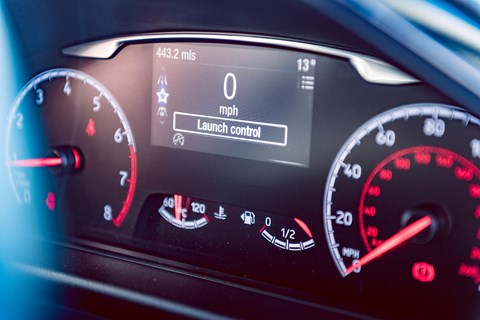
This rapid-getaway system is temptingly dangled before you on the dash practically every time you stop at a junction, like a digital Mrs Doyle. Launch control? Ah, go on, press OK. Go on… That seems to sum up the ST’s inherent hooliganism.
The new turbocharged three-pot turns out to be a cracker of an engine. The Fez arrived with only 438 miles on the clock so it’s still in the running-in phase, but even just tickling the throttle pedal it already feels very torquey and builds speed remarkably quickly for a comparative tiddler of an engine. Characterful, too. Keep the revs in the middle, above the well-suppressed low-down turbo lag, and it sounds like there’s a big, eager bumblebee under the bonnet buzzing away.
On paper it offers the same power as the top version of the old ST but with lower emissions and improved fuel economy. It’ll be interesting to see how close we get to its official combined 47mpg over the next six months. Active cylinder shutdown under low load means it occasionally operates as a twin-cylinder, and the switch between two and three cylinders is impressively imperceptible in action.
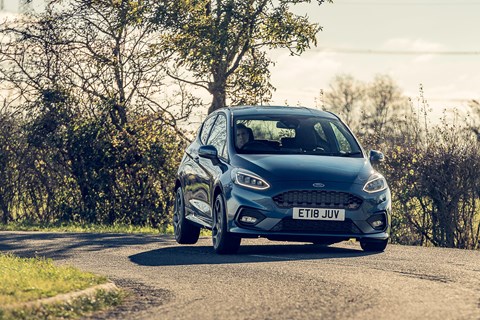
Downsides? The Recaro seats have bolsters so huggy I struggle to operate the steering if I’m wearing a thick jacket. And I’m not sure about the styling. The old ST still looks good, a pugnacious Scrappy-Doo pup, but the new car’s one-box shape reminds me more of a Galaxy people carrier than a rally-replica hatch, especially in its curiously muted Performance Blue paint. And two of the old car’s main drawbacks still remain: harsh solid-sprung ride quality and a giant turning circle for a small car. But if that’s the price to pay for what should turn out to be a lot of driving pleasure over the next few months, I’ll be able to live with it.
By James Taylor
Logbook Ford Fiesta ST
Engine 1499cc 12v turbo 3-cyl, 197bhp @ 6000rpm, 214lb ft @ 1600rpm
Transmission 6-speed manual, limited-slip differential, front-wheel drive
Stats 6.5sec 0-62mph, 144mph, 136g/km CO2
Price £21,995
As tested £24,890
Miles this month 282
Total 720
Our mpg 27.3
Official mpg 47.1
Fuel this month £52.55
Extra costs None